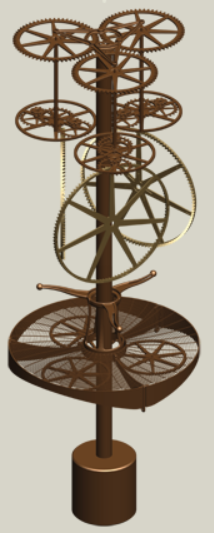Engineers at The Long Now Foundation are using PTC’s Mathcad and Creo to design the first of several 300-foot clocks as the ultimate monument to optimism and long-term thinking.
 Imagine a 300 foot clock sheltered deep inside a mountain hideaway. For 10,000 years it marks the passing of time, its titanium gears, ruby latches, and sapphire movement all perfectly fitted and working in unison. A 9 foot pendulum swings back and forth glacially within the mountain walls, with slow ticks and tocks (one every 10 seconds), until the clock’s chimes ring out with a unique melody that doesn’t repeat once in its 10,000 years of existence.
Imagine a 300 foot clock sheltered deep inside a mountain hideaway. For 10,000 years it marks the passing of time, its titanium gears, ruby latches, and sapphire movement all perfectly fitted and working in unison. A 9 foot pendulum swings back and forth glacially within the mountain walls, with slow ticks and tocks (one every 10 seconds), until the clock’s chimes ring out with a unique melody that doesn’t repeat once in its 10,000 years of existence.
Sounds like something out of The Hobbit, right? The Clock is real, the product of inventor and futurist Danny Hillis and The Long Now Foundation. The Clock now being built inside a mountain in western Texas, the first of many millennial clocks the designers hope will be built around the world and throughout time. There is a second site for another clock already purchased at the top of a mountain in eastern Nevada, a site surrounded by a very large grove of 5,000-year-old bristlecone pines. Appropriately, bristlecone pines are among the longest-lived organisms on the planet. The designers of the Clock in Texas expect its chimes will keep ringing twice as long as the oldest 5 millennia-old bristlecone pine.

Ten thousand years is about the age of civilization, so a 10K-year Clock would measure out a future of civilization equal to its past. The project is seen as an elegant monument to optimism and thinking for the long term. Its creator engineers at The Long Now Foundation, Taylor Roan, Luke Khanlian, and Zoe Stephenson, are passionate about their work.

Roan explains the vision: “Danny Hillis is one of the founders of The Long Now Foundation, which all began with an observation on how businesses, society, and people in general think about time. We only really concentrate on things by the quarter or the year and we only really think about the future with a science fiction mentality. So Danny came up with this idea of a clock that would be able to tell time for 10,000 years. He found the very idea of The Clock got others thinking about the future in a whole new way and it inspired this sense of hope and excitement about the future.”
Early on, the engineering team encountered the difficulty associated with the sheer size of building a 300 foot clock, realizing it was important to build a purely mechanical clock. Electric components couldn’t be considered because of longevity and it was necessary to build a clock that could easily be serviced—or designed not to require servicing—with components that could easily be replaced. The engineers built The Clock in a way so that the mechanics are exposed, so anyone with a basic engineering background could look at the inter-workings and figure out how it could be serviced in the future if needed.
Khanlian explains, “We had to essentially pick up on the mechanical clock design from 100 years ago so that it would last for 10,000 years and combine those designs with technology and ideas of present day. From a design perspective, we wanted to make it timeless—no pun intended—and of course it needed to be 10,000 years compliant in a functional state.” Stephenson adds, “This idea of a transparent design is central to the design of The Clock.”
The design team selected PTC Mathcad Prime 2.0 and PTC Creo for their work. Taylor says, “A lot of mistakes can happen with a project of this scale. PTC Mathcad keeps track of units and does a lot of the grunt work for us so that we can calculate more quickly. On top of that, we can share our progress and design with the founder of the company and other members because it’s a good documenting tool. It’s very legible and printable which takes away confusion for many members of the team.”
Khanlian explains, “It’s easy to pass data from Mathcad to Creo. Mathcad informs the design using data and then I use Creo to realize the particular parts. It’s a robust tool that helps in writing equations that in turn helps to create the geometry needed.”





